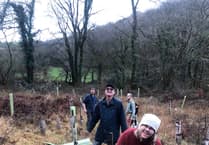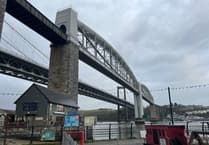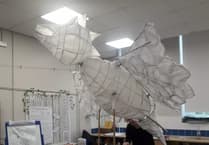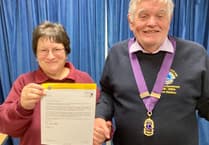Those of us that live or walk in the Wearde vicinity of Saltash, associate the area now with housing and schools.
However, over 110 years ago, Wearde was quite a different place, with its rolling fields and uninterrupted views across the River Lynher and Hamoaze.
Now at Wearde sits Saltash Community School with Bishop Cornish School as its close neighbour; and there are many hundreds of houses built where these fields were. Yet, the story of Wearde is steeped in history, which Saltash Old Cornwall Society’s president Sue Hooper, reflected upon during her lecture to its members at their recent meeting.
On August 4, 1914, England declared war on Germany. England had been preparing for war for quite some time; and Saltash like all villages, towns and cities played significant roles in defence and training strategies and preparations for war well in advance. Moreover, Wearde Farm was one of those important sites that were used to eventually host 5,000 troops from August 1914 onwards.
Hosting men of the 3rd Battalion Kings Own (Royal Lancaster Regiment), plus new recruits were stationed at Wearde Training Camp. The camp was in the fields between Cross Park and Wearde Farm; in the area which is now Broad Walk and the adjoining roads.
The 3rd Battalion Kings Own (Royal Lancaster Regiment), plus 900 new recruits, arrived at Saltash from Lancaster. They were quartered at the Parish Church Rooms, YMCA, Saltash Guildhall, Balfour Hall, Territorial Drill Hall, Boy Scout Room, Masonic Hall, Star Hall, Albert Hall, Alexandra House, and in local Sunday Schools and Day Schools. They were shortly to move into tented accommodation on the land at Wearde Camp.
Eventually after just a few months the Troops including the Somerset Territorials were moved into their tented accommodation on the land at Wearde Camp. Their encampment comprised of hundreds of tents, which were not ideal in the wet seasons.
Eventually, some months later, more sophisticated accommodation was built for the Troops such as wooden huts placed on concrete and stone foundations. They were built in the sloping fields and within the grounds of what is now Saltash Community School. The Troops were glad to be on more substantial footings as they were often camped in quagmires due to heavy rain falls
Over 2,000 tons of stone for the huts were supplied by Messrs. Jeffords quarry at Tor, in Burraton Coombe between October 1914 and April 1915, with a further 900 tons to improve all the access roads. The “C” Company of the 4th East Surrey Regiment was also stationed at Wearde.
In 1917 Field Marshall Viscount French who had commanded the British Expeditionary Force in France visited the camp to inspect the Troops. The enormous toll of casualties on the Western Front eventually changed the role of the Wearde encampment from a military training base to a hospital for the wounded. After the war in 1920 the Camp became the Queen Alexandra Convalescent Centre — under the auspices of the Ministry of Pensions; with the patients being dressed in light blue clothing.
Whist the Troops were stationed at Wearde, they managed to socialise, and arranged trips into Saltash to visit the hostelries and meet a few young ladies too! Some families from those romances still live in Saltash today.
The people of Saltash were greatly supportive of the servicemen during the war and later the hospital patients and events were organised for them. There was also a Wearde Camp Amateur Dramatic Society and a Camp Cinema.
When the hospital became redundant and the huts were removed during 1927/28; just one remained which was at St Stephen’s village and known as St Stephen’s Hall, and was closely associated with St Stephen’s Church. The hut was removed some years ago, and a bungalow now sits on that site just down from St Stephen’s Church and the Cecil Arms.
When the servicemen visited Saltash Town there were frequent reports of drunkenness and disorderly behaviour in Tamar Street, but not too many problems. In the main the people of Saltash were greatly supportive of the servicemen during their stay training and later the hospital patients; and indeed events were organised for them.
The men also arranged their own entertainment using many of the facilities provided for them at the encampment, including a cinema and amateur theatre. The men organised a concert at the camp to benefit St Stephens Church organ fund which included the camp Male Voice Choir and Camp Orchestra. Other amusements on site were football (a team played a charity match at Home Park against Argyle reserves in 1921.) boxing, boating, cinematography performances and five hole golf (a course was laid out on the sports field). Their annual sports day included threading the needle, throwing the cricket ball, bun-eating competitions, egg and spoon races, blindfold races, greasy pig competitions, potato races, best costume competitions, and wheel barrow races. These were very popular sports days where there were many hundreds of entries recorded.
In 1923 Saltash Borough Council agreed that patients at Wearde Camp when in hospital blues could use the ferry, free of charge.
Eventually, and after many strong debates over several months the hospital itself finally closed in March 1927. Which was followed by auctions of all the items, equipment, bedding, soft furnishings, hospital uniforms, larger furniture and so on?
Auctioned off were 1,324 chairs, 491 hair mattresses, 822 pairs of curtains (long and short), 783 blue trousers, 609 flannel and woollen drawers; plus extremely valuable engineering equipment. Moreover, 1,000 feet of asbestos
Saltash businesses suffered great losses due to the closure of the hospital, and there were a lot of complaints from the business community. The local Co-op in Fore Street, Saltash, reported losing almost £300 in one year, which was a lot of money 100 years ago!
During 1936 a King George Jubilee Trust Fund and Plymouth Juvenile Council was set up and money used in association with Sir John Carew Pole.
In 1936 the Meccano Guild was set up in the St Stephen’s Church hut, for boys with a great interest in Meccano. The boys built a model of the GWR which was under construction at Millbay Station in Plymouth; the station was sadly destroyed by enemy action during 1941.
In 1937 some of the money from the King’s Trust was put towards a youth instruction centre based at Wearde. Further, in 1938 for the Saltash Miniature Rifle Club, additionally, partly used as a camp by Plymouth Juvenile Association; later was also considered as a site for Torpedo Training School.
Sue stressed that where the camp once stood is now grass land, schools and houses, and nothing remains of the buildings which so many military personnel vacated to fight on the Western Front and to which some returned to recuperate from their traumatic experiences – sadly, many did not survive the war.
In 2019 the Saltash Great War Committee commissioned a musical play about the life at Wearde Camp from 1914 until 1920’s called Lowena. It was a beautiful love story and reflected the life at the encampment and its strong community spirit.
In addition, the Saltash Great War Committee has erected a Memorial Plaque on the school building, and history board on the verge of Saltash Community School with much more information of the history of the Wearde encampment. Sue invited the listeners to pay a visit and look at the board, to learn so much more of Wearde Camp and its historic mystery, and the vital role it played during and after the Great War, which must never be forgotten.
Sue concluded her lecture by sharing many of her historic photographs and postcards of Wearde Camp during and after WWI.Sue referenced the additional source of her research to being from John Hooper’s book, ‘Captain Jackson, HMS Defiance’ - and Lynn Marsh (WW1 Committee).
Martin Lister, secretary of the Saltash Old Cornwall Society in his vote of thanks to Sue, said: “From our work together on the WW1 Commemorative 100th Anniversary Committee, I was aware of Mrs Hooper’s vast knowledge regarding Wearde Camp and its varied history, with up to 5,000 Troops based there throughout; which clearly played a major part in Saltash’s wartime history and indeed, as we have learned, its post war history. Mrs Hooper’s research and references to various periodicals and books on the subject, has been phenomenal and we have all been privileged to share in the fruits of this research. A fascinating experience for which I would like to thank her on behalf of us all.”




